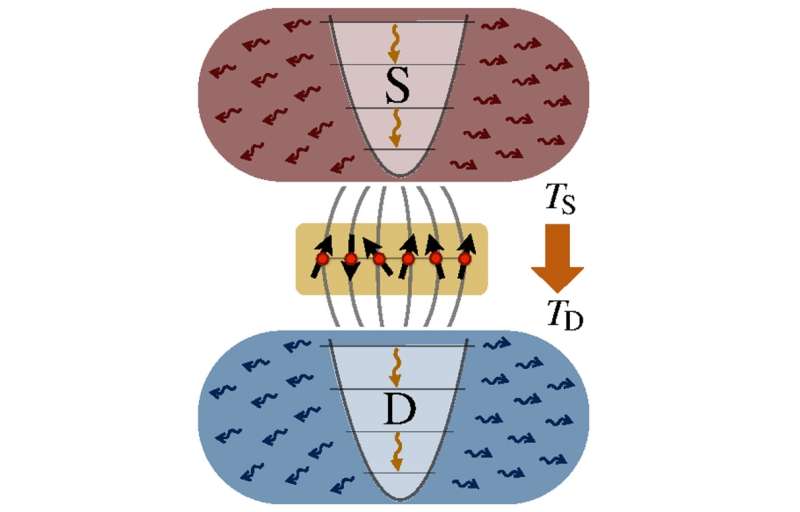August 29, 2016 report
Physicists propose first method to control single quanta of energy

(Phys.org)—Physicists have proposed what they believe to be the first method to control the transport of energy at the level of single energy quanta (which are mostly phonons). They show that it's theoretically possible to control the flow of single energy quanta through a quantum magnet using lasers with carefully controlled frequencies and intensities.
If implemented, the method could allow researchers to explore quantum energy transport phenomena that are expected to be completely different than what is observed in macroscopic energy transport. In general, understanding energy transport in small-scale devices could lead to the development of methods for reducing the energy dissipation in shrinking computer hardware (however, the researchers note that computer hardware differs from the particular setup proposed here).
The scientists, Alejandro Bermudez, at the Institute of Fundamental Physics in Madrid, Spain, and Tobias Schaetz, at the Albert Ludwigs University of Freiburg and the Freiburg Institute for Advanced Studies, both in Freiburg, Germany, have published a paper on their proposed method in a recent issue of the New Journal of Physics.
"We have identified a new quantum mechanism that would allow to control the transport of energy/heat at the level of single energy quanta," Bermudez told Phys.org. "This mechanism can be considered as an analogue of Coulomb blockade in electronic nanodevices, and we have proposed to test it using experiments with crystals of self-assembled trapped atomic ions."
In the study, the scientists propose building an energy reservoir using trapped magnesium ions. By using a laser to heat and cool the ions, the ions can be made to absorb or release tiny amounts of energy, acting as tiny energy reservoirs.
Then to transport the energy, the researchers propose placing a synthetic quantum magnet—which consists of a long line of magnetic spins that form a chain—between two energy reservoirs. When the reservoirs are coupled to the spins in the magnet, they can exchange energy with each other in the form of single phonons. In this way, quantum-scale energy transport occurs across the spin chain.
The scientists explain that energy transport at the quantum level can be thought of as analogous to charge (electron) transport at the quantum level, which has already been well-documented. Just as single-electron transport is very different than bulk electron transport, quantum energy transport is expected to be very different than energy transport on a large scale.
One particular phenomenon associated with single-electron transport, which is not observed at larger scales, is called the Coulomb-blockade effect. In nanoscale electronic devices, electrons must gain a certain level of charging energy in order to tunnel across a barrier. When one electron manages to gain this energy and tunnel, it blocks the simultaneous tunneling of other electrons because additional electrons would require additional energy. The resulting blockade effect violates Ohm's law of charge transport, and results in only one electron tunneling at a time.
In the new study, the physicists theoretically demonstrated that an analogous Coulomb-blockade effect occurs with nanoscale heat transport, which again does not appear at larger scales. The scientists derived a quantum master equation for the transport of energy that shows that there is a "transport window" that defines the energy level needed for energy quanta to travel through a quantum magnet. Similar to the situation with electrons, energy transport is blockaded when the energy quanta do not have sufficient energy. This effect, which the researchers call the Ising blockade effect, violates Fourier's law of heat conduction and results in the transport of only one energy quantum at a time.
If the proposed experiment can be realized, the researchers expect to observe the Ising blockade effect along with many other interesting quantum effects in energy transport that so far have been restricted to electronic currents. At this stage, it's difficult to tell what applications quantum energy transport may have.
"If the same effect can be shown to be more general, and applicable to other physical setups, it may yield unexpected applications similar to single-electron electronics in Coulomb-blockaded devices," Bermudez said.
One of the biggest challenges to realizing the experiment will be to design a device that can directly measure such tiny amounts of heat energy.
"We are considering exploring this type of physics in the laboratory of my coauthor, Professor Schätz, at the University of Freiburg," Bermudez said. "Although the experimental requirements to implement the proposed scheme are stringent, Professor Schätz leads a world-class team of fantastic researchers with the required technology to face this challenge."
More information: Alejandro Bermudez and Tobias Schaetz. "Quantum transport of energy in controlled synthetic quantum magnets." New Journal of Physics. DOI: 10.1088/1367-2630/18/8/083006
Journal information: New Journal of Physics
© 2016 Phys.org



















